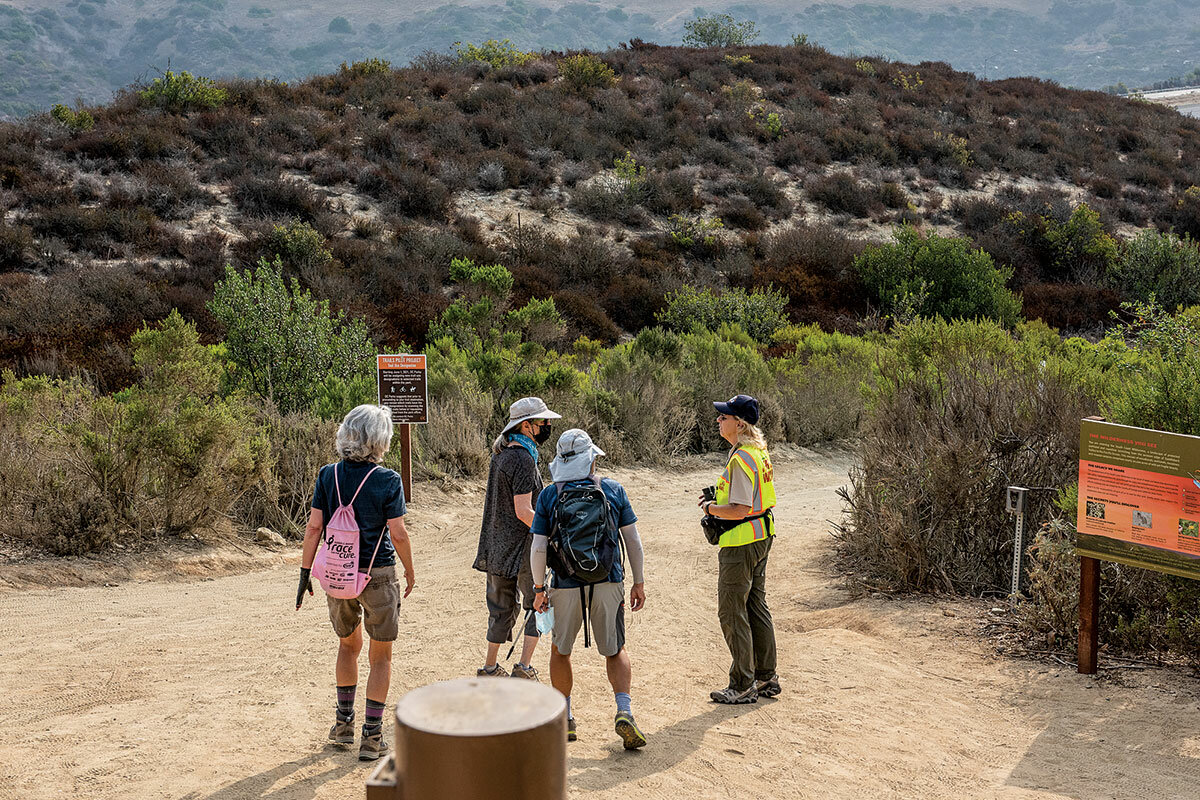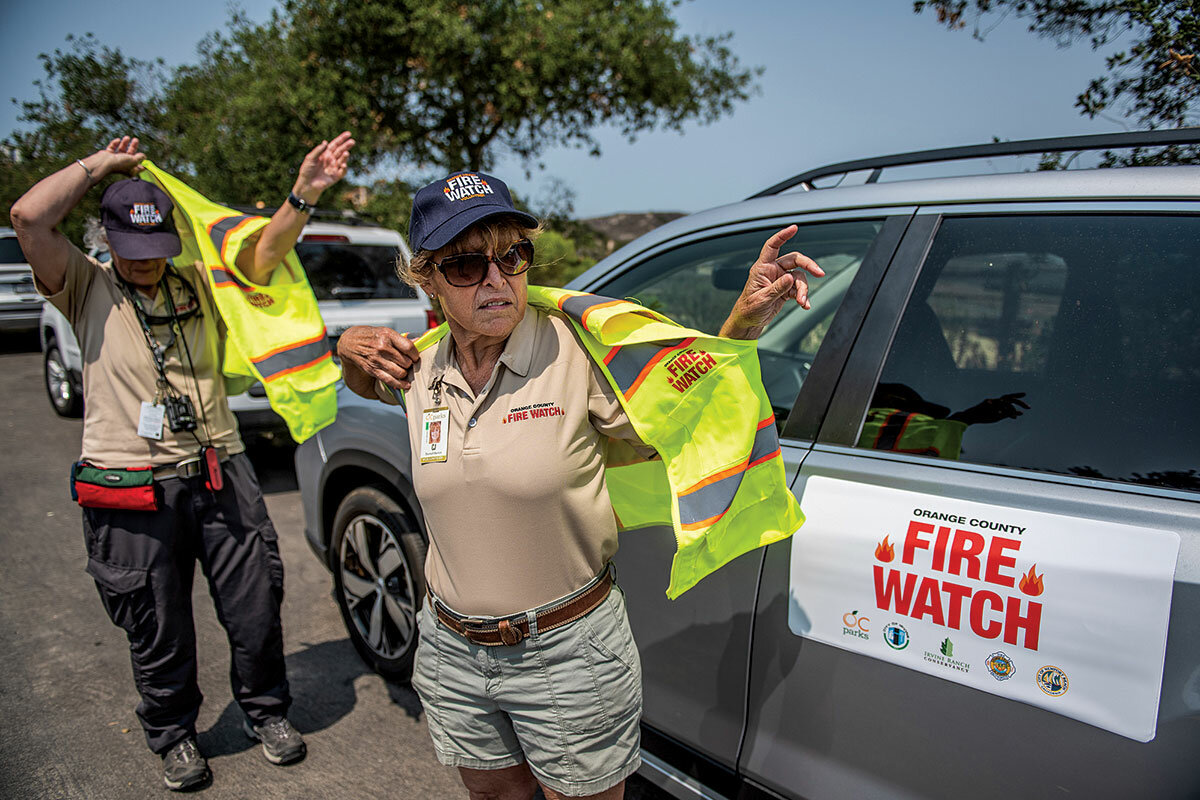On wildfire patrol: Volunteers gauge success by blazes that don’t start
Loading...
| Brea, Calif.
When Southern California turns into a tinderbox – with dry winds whipping across parched canyons and foothills – Ray Hutchinson grabs his portable ham radio, dons a reflective vest the color of lemon-lime Gatorade, and heads for the outskirts of Orange County to scan for smoke and flames.
A retired fire captain, Mr. Hutchinson is part of Orange County Fire Watch (OCFW), a group of 328 volunteers who patrol wilderness parks, remote highways, and even a cemetery when the threat of wildfires looms. The goal is to deter arsonists, educate the public about fire safety, and spot blazes before they swirl out of control, says Tony Pointer, who manages the network for the Irvine Ranch Conservancy, which oversees nearly 30,000 acres of open space.
“What a great way to give back. I get to stand and look at beautiful country,” says Noma Bates, another volunteer.
Why We Wrote This
In the battle against catastrophic wildfires, these volunteers patrol Orange County’s backcountry to prevent blazes before they start while educating the public about fire safety.
Mr. Pointer adds, “We sell Orange County Fire Watch as the easiest volunteer activity with the most impact on the land.”
But being a wildfire watchdog is no walk in the park. Well, actually, it often is a walk in the park, but under dicey circumstances.
“If the wind is high, it’s awful,” says Lynda Armbruster, citing dust-bowl conditions that require goggles and a mask. Nevertheless, she regularly signs up for six- or eight-hour shifts. “You protect what you love,” explains Ms. Armbruster, a retired college professor who’s been with OCFW since its inception in 2006. “It’s like people who rescue animals. You have a thing that captures your heart.”
In California’s unending battle against wildfires, an ounce of prevention is worth a pound of insurance payouts and charred countryside. The fire watch was formed with that in mind, and its members feel passionate about “helping the land stay safe,” Ms. Bates says.
On average, Mr. Pointer says OCFW patrols 18 to 20 days a year, mostly in the fall and winter, with up to 70 volunteers in the field at a time.
Invariably, the trigger is a weather phenomenon that inspired this 1938 passage from novelist Raymond Chandler’s “Red Wind”: “There was a desert wind blowing that night. It was one of those hot dry Santa Anas that come down through the mountain passes and curl your hair and make your nerves jump and your skin itch. On nights like that every booze party ends in a fight. Meek little wives feel the edge of the carving knife and study their husbands’ necks. Anything can happen.”
It’s that “anything” factor volunteers are urged to zero in on: suspicious activity (“hikers” wearing street clothes or taking photos), people operating weed wackers (which can throw off sparks), cars pulling onto grassy shoulders (hot catalytic converters can ignite vegetation). In 2017, a road flare that skittered off a freeway started the Canyon Fire, which burned 2,600 acres and sparked a second, larger inferno.
“Thank you for saving us”
Everything gets reported to OCFW’s command center via cellphone or ham radio. After Ms. Armbruster called in the Canyon Fire 2, she was besieged by “panicked residents asking me what to do. I told them to pack their cars and be ready to go.” One family later drove up and rolled down a window, and a 3-year-old boy chirped, “Thank you for saving us.”
OCFW is a vast improvement over fire reconnaissance in the 1800s and early 20th century, when lookout towers were the chief detection method in the United States – and bells, flags, lanterns, and heliographs (Morse code via mirrors and sunlight) were the only ways to communicate.
Orange County’s first lookout station debuted in 1912 atop Santiago Peak in Cleveland National Forest and had an Osborne fire finder (a sighting device to pinpoint smoke locations) and a direct phone line to the fire warden’s house, according to old newspaper articles unearthed by Ron Kemnow of the Forest Fire Lookout Association.
One of the tower’s earliest employees, Winifred Hunter, moved in “with her gun and two dogs” after a string of male lookouts buckled under the solitude.
By 1946, three more observation towers had sprung up in the county, but gradually fell into disuse, rendered obsolete by spotter planes, budget cuts, and poor visibility caused by smog. Today, the county’s only lookout stations are replicas at Disney’s California Adventure theme park.
The concept behind modern flame scouting originated in the mid-1970s. A fire prevention officer in San Bernardino, California, hatched the idea of adding volunteer CB radio operators to the “Red Flag Fire Patrols” conducted by forest rangers, according to a 1974 San Bernardino Sun story. Like their 2021 counterparts, the CB crews worked in pairs and drove around with magnetic “Fire Patrol” signs affixed to their cars.
Actor Buddy Ebsen of “Beverly Hillbillies” fame organized a similar program – Arson Watch – in the Malibu area after a 1982 wildfire nearly torched his ranch.
Cellphones fueled the latest crop of patrol groups. OCFW is the largest in Southern California, Mr. Pointer says, but there are dozens of others.
Most of OCFW’s members are retirees and nature lovers who joined the program after volunteering with the county parks system or the Irvine Ranch Conservancy. Both agencies mandate multiple hours of training, including CPR and first-aid classes.
Fire watch recruits get an additional four hours of instruction, along with a manual that covers everything from how to park your car while on duty (always facing out, for quick escape) to where to find restrooms at the 35 locations that members monitor when the National Weather Service declares “red flag” fire danger.
Most of the watch sites are near park entrances or along canyon roads. Less extroverted volunteers can sign up for a dam that overlooks a Christmas tree farm, an oil field, and one of Southern California’s biggest redwood groves. Or they can lurk at the back of a Catholic graveyard with panoramic views of high-risk mountainsides.
Watching via camera during pandemic
The group also keeps tabs on 34 wilderness cameras set up by utility companies, a popular option during the pandemic. During 2020’s Blue Ridge Fire, remote observers spotted a small, secondary blaze even before nearby residents noticed it, Mr. Pointer says.
How effective is OCFW’s program? The best measure would be the number of blazes that never start, but that’s impossible to quantify, says Sean Doran, an Orange County Fire Authority captain. “We appreciate partnerships of any kind, and having volunteers out there is a deterrent,” he adds, noting that the majority of wildfires are caused by people, although usually inadvertently.
In a typical year, OCFW reports four smoke or flame sightings, Mr. Pointer says. “We handle more medical emergencies,” he adds, because volunteers posted at trailheads routinely encounter injured hikers.
“There’s not a lot of glory,” says Mr. Hutchinson, the retired fire captain. “But there’s lots of appreciation.”
People drop off cookies, deliver hot chocolate, and honk their horns, volunteers say. And there are less conventional rewards. “One guy asked if I wanted free gun training,” Ms. Armbruster recalls.
Interacting with the public and explaining fire safety is “a big part of our success,” says Mr. Pointer, who hopes to expand to 500 volunteers covering 50 sites.
Although video feeds and artificial intelligence are gaining ground in fire detection, he says, they’re no substitute for a human touch. AI sometimes mistakes clouds – or dust kicked up by a truck – for smoke, he notes. Ultimately, he says, “I don’t see how you can replace a person.”







